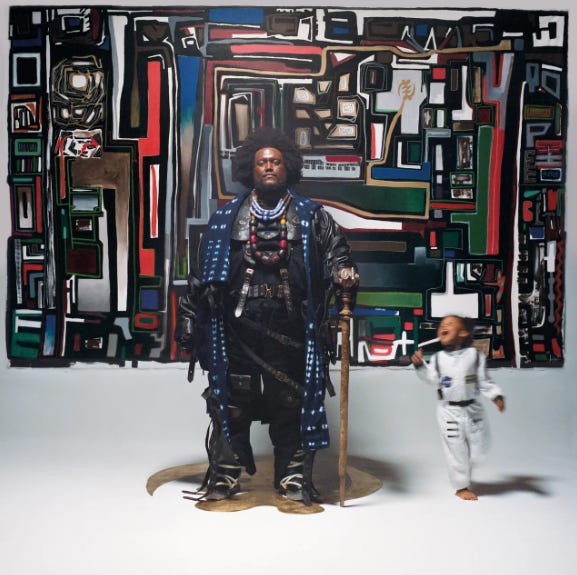Kamasi Washington has become a modern titan of Jazz. The genre has long since faded into obscurity, not really noticed much by the mainstream, but Washington is one of the few who has broken through. He’s won a litany of awards since releasing 2015’s The Epic, he was tapped to create the music to accompany the Michelle Obama Becoming documentary on Netflix, and then tapped again for The Metallica Blacklist.
As much as any Jazz artist could become mainstream in the last 20 years, Kamasi Washington has exceeded those expectations and limitations.
I should also point out that Kamasi made my 2024 wishlist, specifically for artists who hadn’t produced an album in over five years. And he’s the first artist, out of 24 total, who pulled through.
For good reason. His music is intense and technical, yet passionate and emotion-filled. It is everything that Jazz is meant to be. Granted, that means that those of you who don’t like long-form music (or are unmoved by instrumental-only music) are not necessarily going to love much of his work. His much-lauded breakout album, The Epic, truly was epic, at a total playtime of two hours and fifty-three minutes. By comparison, Fearless Movement is half the length — twelve tracks which total one hour and twenty-six minutes.
But it’s truly a blissful experience with energetic highs and soulful lows.
And large stretches of the album would be right at home on a Cowboy Bebop soundtrack; all the album lacks are Mai Yamane’s silky-strong vocals on one or two flagship songs.
But the first half of the album features several guest artists, including verses from Taj and Ras Austin on “Asha the First”, along with Jazz bassist Thundercat; silky Blues vocals from Patrice Quinn on “Computer Love”; Terrace Martin singing and scatting on “The Visionary”; and even Andre 3000 with his flute on “Dream State”, plus a few others.
There’s a ton of variety here, from the most cerebral Jazz to the dirtiest Funk (“The Visionary”). And all of it is rooted with what you see on the cover — Kamasi dressed in a mix of traditional and modern clothing, standing firm, with his daughter, Asha, dancing beside him in an astronaut costume. It’s truly one of the best, and most thematic, album covers I’ve seen in a while.
Since his last album, 2018’s Heaven and Earth, Kamasi has been through a lot. He’s a father now, and, like the rest of us, he weathered Covid with all of the fear and anxiety that a pandemic inspires, plus a bit more for that brand new baby girl. This album’s conceptualization began there, stewing in that.
The album then kicks off with “Lesanu”, which begins with a prayer in Ge’ez, the language of the Ethiopian Orthodox Bible. According to Washington, it’s a song dedicated to a friend who passed away. It’s also the perfect opener, full of complexity and searing emotion, especially in the sax solo.
Track two, “Asha the First”, kicks off the run of songs with guest artists who leave their own mark on the record, which ends on track seven, “Together”. “Asha the First”, is, of course, named after his daughter, and it seems that the song’s initial vocal melody was her creation, which just makes it more endearing. It takes a sharp turn, though, at about halfway, as the Austin brothers1 come in with hard-hitting rap verses about trying to survive in modern America, raise a family, and protect your kids from the school-to-prison pipeline.
With the exception of tracks like “Computer Love” and “The Visionary”, which deal more with trying to find a partner, the album places the concept of family front-and-center. It’s foundational to the passion, energy, and themes of the music. And you might counter with “how are there themes if it’s mostly instrumental?”
With the lyrics that are present;2 with the tone of the music in each track, such as the overwhelming sense of hope in closing track “Prologue”; with the cover art being what it is paired with the fact that the closing track is titled “Prologue”…
It can’t be more clear.
Kamasi clearly put a ton of time, energy, and heart into this record. It shows.
Sure, the vocal lines and melodies in “Lines in the Sand” are a bit too repetitive, especially because three-fourths of the lines of every quatrain start with the title of the song, but the points made are still solid. Sure, it’s a bit odd to have a soulful blues number about online dating in an album that is predominantly about family.
There are some missteps, in my opinion. But the experience at-large is still extremely good, and there really is more to unpack here than I could ever do with my limited technical knowledge.
Bottom line: it’s a really good album, and if you’ve ever wanted to dive into a bit of Jazz, even if it’s overwhelming, Fearless Movement could definitely be a good starting point. He isn’t what I would consider a Jazz gateway artist, but his compositions and skill have still given him some ability to hook new listeners.
Rating: Blue
Taj and Ras Austin are the twin sons of Teedra Moses, an R&B and Soul vocalist from New Orleans. The brothers are also members of the hip hop group Coast Contra.
Even once the featured artist credits disappear, tracks 8 and 11 still have vocal sections with support from Patrice Quinn and Dwight Trible.





